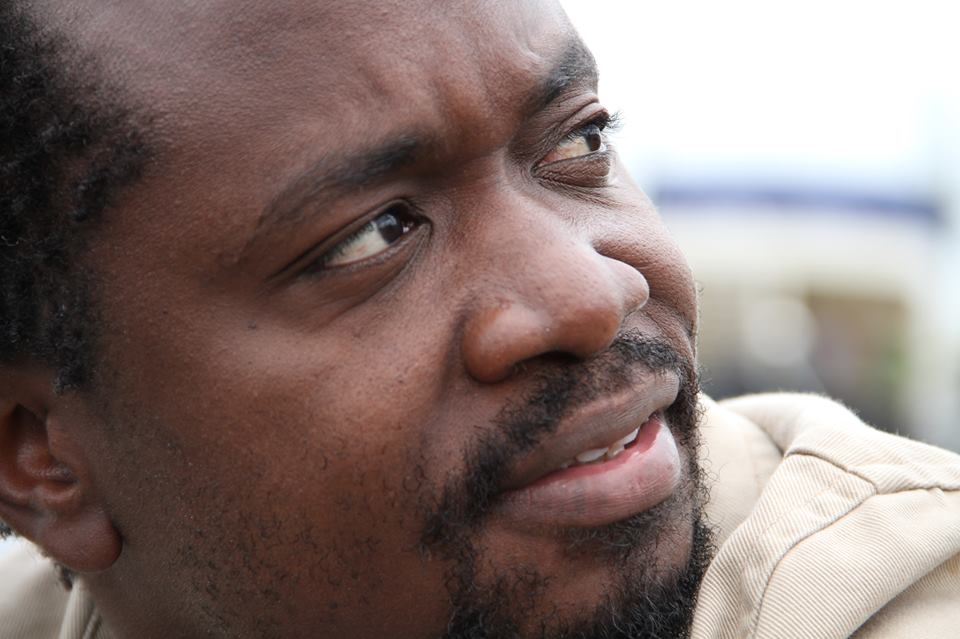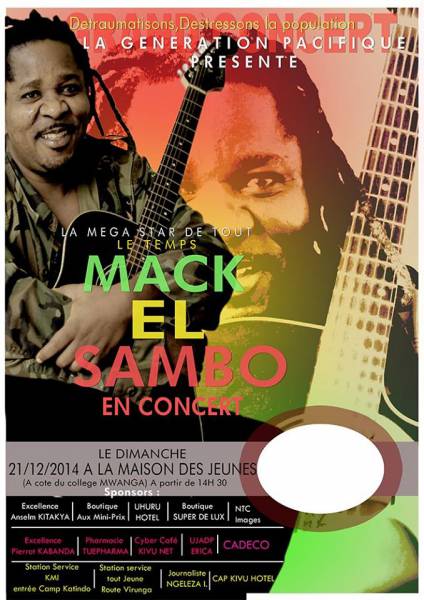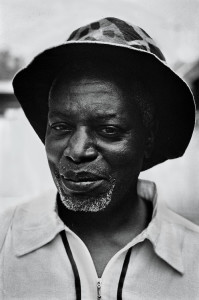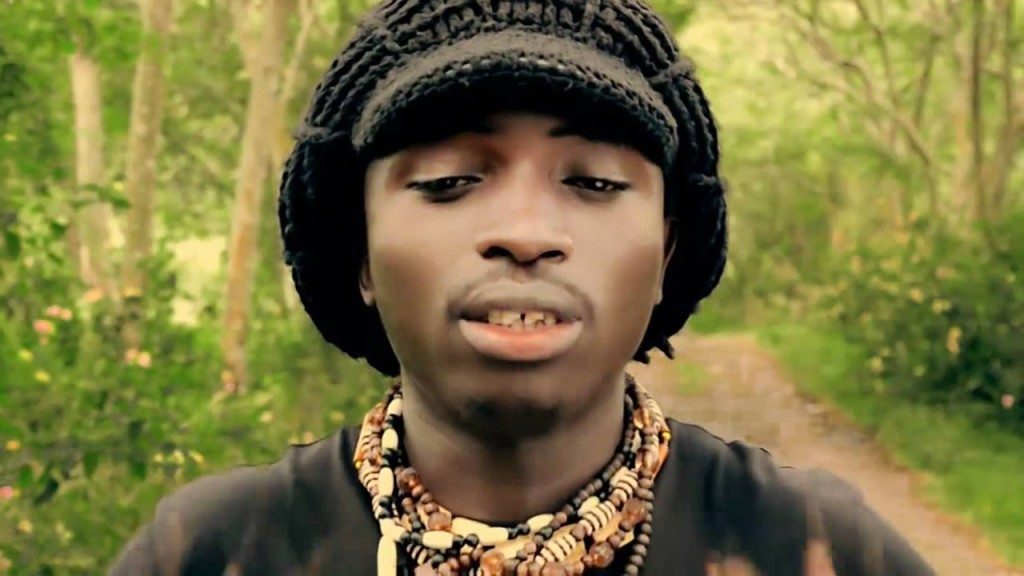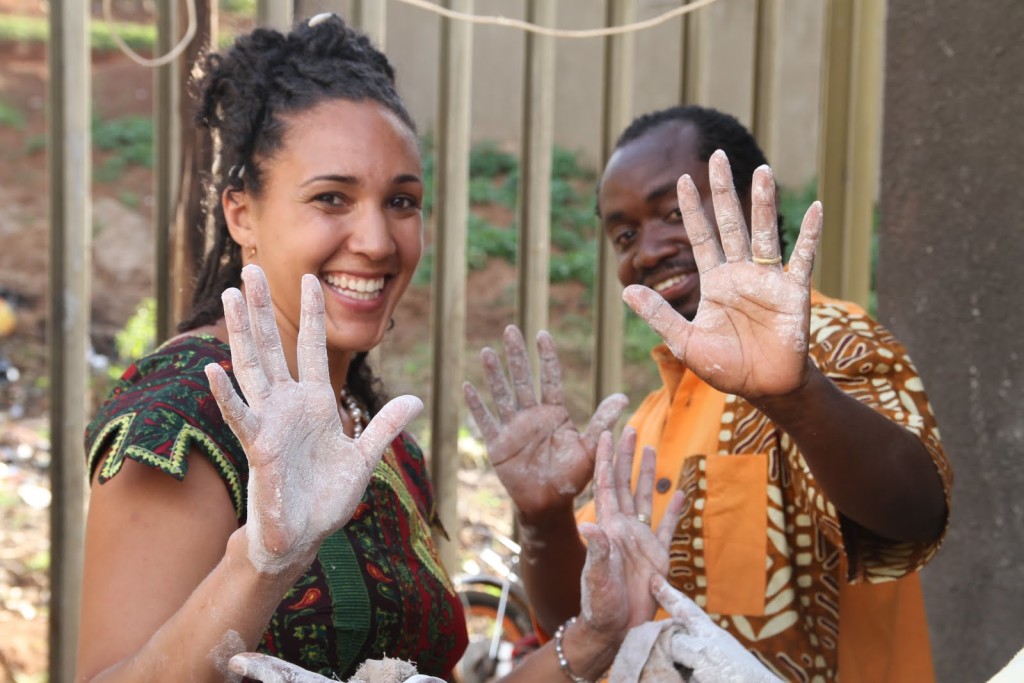Hip Deep scholar Chérie Ndaliko took the time to go into detail with us about music, activism and "charitable imperialism" in the east of Congo for our recent program Congo-Goma: Music, Conflict and N.G.O.s. Alongside her husband Petna Ndaliko, another advisor for this program, Chérie is codirector of the Yolé! Africa Cultural Center.
Morgan Greenstreet: Why don’t you start by introducing yourself and telling us a little bit about what you do.
Chérie Ndaliko: My name is Chérie Ndaliko. I am codirector of the Yolé!Africa cultural center in Goma. I am also a professor in the music department of the University of North Carolina at Chapel Hill, where I research and teach about artistic radicalism and the potential of cultural activism to catalyze meaningful and sustainable socio-political change.
I’m looking forward to reading your forthcoming book. What is it called, and what is it about?
My book is called Necessary Noise: Music, Film and Charitable Imperialism in the East of Congo. It is going to be published by Oxford University Press in 2016. It is, on one level, an ethnographic study of Yolé! Africa as a catalyst of artistic resistance in the North Kivu province in the east of Congo. It is a study that looks at the history and the aesthetics and the ideology of artistic resistance in musical and in cinematic form; and it really tries to get at what are the real ways that we can link art to socio-political change responsibly, so we’re not just doing it in a way that celebrates creativity because it’s happening against a backdrop of violence, but because we’re looking at what are the really meaningful socio-political functions of art in the kind of environment that has shaped the east of Congo, Goma in particular.
This study starts from about 1994, in terms of the current iteration of artist-activist figures, all the way up to the present. And then, of course that is all cast in a larger historical context that goes back to Congo’s encounter with Europe and the kinds of dynamics that were ignited under King Leopold [of Belgium] that have been going through various metamorphoses and have left various lingering imprints on the individual and collective psyche, if you will, of the population, and the ways that that is activated in relation to much of the humanitarian activity that’s taking place currently, specifically again in North Kivu.
Awesome.
Wow, did we record that? I’ve been trying really hard to write the synopsis of my book! [Laughs]
Yeah, we just recorded the synopsis of your book, and in one breath too! So how did you arrive in Congo for the first time? And what was your impression of Yolé! Africa the first time you arrived there?
I encountered Yolé! Africa when I was doing my doctoral research. I had successfully defended my dissertation that included a comparative study between four different countries. The Congo was one of them, and it was the one about which I knew the least. I had conducted extensive research in Mali, I had conducted fairly extensive research in Kenya; I had done a hefty, hefty amount of preliminary research in South Africa, which was the third country, and I hadn’t done anything in Congo. And I was back in the United States for a brief moment and [I attended a film screening and discussion of Petna Ndaliko’s work]. I was very impressed, and the conversation which took place in the auditorium after the screening, was a profound conversation. Around 300 people were just utterly [engaged]; you could hear a pin drop, and the kinds of things people were able to articulate were just really, really powerful. So I started looking into Yolé! Africa, and eventually made my way to Goma. It was a very actively volatile time, and I had no context for understanding how dangerous it was or wasn’t.
When was this?
In 2008. I spent so much more time thinking about my material conditions that when I got there, I hadn’t formed very concrete expectations of what I would find. I think that was a gift. I was immediately struck by the vibrancy, and I mean that in terms of the physical beauty of the place, and I also mean it in terms of the artistic energy that was just this wall that washed over me in a really powerful way. I spent five weeks during my first research trip, and after five weeks it was crystal clear to me that there was no ethical way I could do a comparative study between Yolé! Africa and the other cultural centers that I had been working with for years in the other countries that I named. And so, after doing some soul searching and some renegotiating, I realized that I was actually going to be writing a dissertation exclusively about Congo and featuring Yolé! Africa quite significantly, because what I found at Yolé! Africa was so potent, it was so radical and it was palpable, the transformative effect that art was having on the youth in this community.
 Crowd at SKIFF 2012. Photo by Allason Leitz
Crowd at SKIFF 2012. Photo by Allason Leitz
Yolé!Africa is an organization that is so fundamentally committed to the autonomy and the respect of the local community and navigates any potential interaction with a foreign entity based on those principles. It is an organization that was courageous enough to do that, knowing that financially, that is suicide. What grew up in the wake was an incredibly precarious administrative task, but the effect on the young people was just so evident to me that since then, I have been trying to make heads or tails of it, and I’ve been doing that as a researcher, and I’ve been doing that increasingly as a participant in the organization; I now hold an administrative role in the organization, so I offer the support that I can as a grant writer, those kinds of things. What has remained unwavering for me is my curiosity and my deep intellectual, even spiritual engagement with the profound question of what gives this place its flavor, specifically as it’s defined against a backdrop of such extremes. I mean, between volcanoes and rebel militias and the particularly brutal colonial history that lingers over Congo. It’s extreme. The extreme natural resources and mineral wealth and all of that. There’s nothing that is moderate there.
So, it seems to me that there’s way more politically engaged music in the east of Congo, in comparison to the rest of the Congo. In what way is that organic and in what way is that a reaction to these extreme circumstances?
I’m not sure I can separate those things, right? Because to me, it’s a cyclical and mutually influential set of circumstances. The ingredients that I see in that mix are certainly the geographic location and the specific geographic struggles in the east of Congo [including] the isolation of the east from the west, which is the seat of power; so there’s a vast discrepancy in the way in which governmental resources are allocated. It’s also very wealthy in terms of natural resources, which has positioned this region as a site of global pillaging that in turn has led to an influx of charitable and humanitarian actors that have formed a "complex" that intersects on all levels: international, national, regional, community, etc.
There’s a very visceral set of realities that young people in Goma face, that are different from the also very visceral set of realities that young people in Kinshasa, for example, face. But specifically all of the songs that you hear speaking out against war, speaking out against the kind of systemic and mass violence are more prevalent in Goma because that’s the lived reality of the population.
It might be going far to call Goma a hotbed of musical or artistic radicalism, but comparatively, it really is, and part of the why is because of the exaggerated circumstances on all different sides, and part of the why is from the charismatic figures from there, right?
So, Petna [Ndaliko] is the catalyst of a huge portion of the more radical arts scene in Goma. He is sort of elevated to a position of prominence from the east of Congo, and he is the artistic figure who is fundamentally, nonviolently, artistically militant. He has charted a course which allows artistic activism to exist in a militant form and he has, as part of his militantism and part of his legacy, created a structure that fosters those values in future generations of artists. I’ve spent a lot of time interviewing him about his work, and I know that the circumstances in the east of Congo have affected him strongly, and there’s also something in his individual character that prompted him to respond the way that he did. And I think that sort of confluence or mutual influence of factors is very relevant for understanding the kind of political agitation that is audible in the music in the east of Congo that is not comparable to the music that’s coming out of the rest of the nation.
Taking a step back: What are some of the musical styles that artists are working with in Goma, what are some popular styles?
That’s an interesting question. Genre is always a slippery thing, and it is so in Goma as everywhere else. There are many genres of popular music: There are Congolese rumba genres; there’s a very vibrant r&b scene; there are some groups that are really interested in the preservation of what are typically called traditional musical practices. And then there is a growing group of hip-hop musicians and rappers. There is a small but long-standing contingent of reggae musicians: Mack El Sambo is known as the founder of Congolese reggae music, and he is from the east and lives in Goma as well. So there’s a diversity of musical traditions that co-exist. I work most prominently with the artists who designate as hip-hop artists, and that is very much aligned with the social justice conception of hip-hop in the global south, if you will.
Another thing that I’ve noticed about music from Goma, from the North Kivu region, is that a lot of it seems more internationally oriented than music from Kinshasa.
Again, this is very much tied into the history of Yole! Africa. Yole! was founded by Petna, who is from Goma. He spent a portion of his life in political exile in Uganda, which is actually where the original Yole! Africa was founded. Uganda is officially part of East Africa, which is a complex of African countries that have a functional inter-relationship between nations. Yole! Africa in Kampala was very active for a long time; it was a very, very strong and thriving cultural center that had youth members from all the East African countries and from the Horn of Africa, and from a wide region. Many young people from Goma came to study in Uganda, at Yole! Africa in Kampala, and were very much enculturated into this process of hip-hop as an international dialogue, specifically again between communities that one might say are from the global south, communities navigating colonial and other residual forms of oppression. And so the artists that trained then at Yole! in Kampala then come back to Goma and become many of the initial artists to make more international names for themselves, which further entrenched this notion of what hip-hop should be in the east of Congo.
Another factor that figures into that is the fact that what many of the young people, when they were in Kampala, became aware that the conception of the war in Congo, among their peers from East Africa, was warped in a similar way to the warped perceptions in the Western world, that is to say that people thought of it as an ethnic scuffle, and the Congolese just kind of couldn’t work their stuff. And that was very, very frustrating to the more politically savvy young people who really wanted their African peers to understand the geopolitics behind the conflict. And so that preoccupation on their part, combined with their orientation towards hip-hop in a sort of East African, pan-African, African-diasporic, global configuration, prompted them to really think about it as an international mode of communication. I think that there are strains, certainly of internationalism in the hip-hop that takes place in Kinshasa, but it’s generally more in dialogue with Europe.
Definitely. And just the fact that Swahili is one of the main languages spoken in North Kivu connects the region more with East Africa than the west of Congo.
Exactly. And historically there have been periods where the nation was essentially divided, when there was a travel ban and people physically couldn’t get their bodies from one side of the country to the other side of the country. It was very easy to travel to all the other East African countries from Goma, so there was this sense of belonging, culturally, linguistically, economically, to the east of Congo and feeling very, very cut off from the west.
As a historical background to the time period we focus on in our Hip Deep program, what were the conditions during colonialism and precolonialism in the North Kivu province?
It’s a huge question, and there is a comparative dearth of information on the east, certainly in terms of precolonial [history]. What you find often is conversations around Rwanda-Burundi that encompass also the east of Congo. In terms of the specifics during the colonial era, I mean there’s so much that we could say but it would take us very far afield from a conversation about music and art production right now, and it is also not my solid area of expertise.
In the book, I’m more looking at what were the sort of aesthetic and relationship dynamics that were put into place on a meta level as a result of the colonial policies and the way they’ve affected culture and creativity and how now people are encountering very similar projects in the guise of humanitarianism, how the similar aesthetics and relationship dynamics are playing out now. And how the narrative of Congo’s evolution as a whole manifests specifically in the east.
Kivu was part of Leopold’s Congo Free State, and the Belgian colony, but I will say that Kivu was one of the places that held out the longest against colonialism and has the shortest history of actual experiences of consolidated colonial control in all of Congo. And that is very much connected to the self-perception of individuals and communities who didn’t have the impact of multiple generations of colonialism go as deep as other parts of the country did. And that sort of sense that “We were the holdouts and the resistors” is very much part of people’s identities.
Do you feel that the colonial history of being “holdouts” is part of people’s current political standpoint?
Not in a concrete way, but I think that for certain youth leaders, it is certainly a resource. What would probably be a lot more traceable is the fact that the same conditions that created this hold-out scenario are related to all of the other things that make the east unique: Geographic features, wealth of natural resources, etc. There are a whole bunch of features that make this part of the country distinct and all of those, I think, are equally imprinted on the collective identity. So many of those have been real triggers of chaos, of one form or another, so it’s very hard to claim any clean genealogy of cause and effect where we can say, “Because of the colonial holdout, therefore people perceive themselves as resistance artists.” What I’ve discovered is that everything is a lot messier than that, there are so many competing and often conflicting influences, all happening simultaneously.
Right, like real life. [Laughs]
Like real life on steroids. But part of my analysis for why there is, in this particular moment, this resurgence of artistic protest has very much to do with charismatic individuals who, in their own research of the area, take the narratives of the resistance movements that were prevalent in the east of Congo, resisting colonialism. That is very much alive for Petna in terms of his own self-conception and that is very much a foundation on which he’s able to anchor his current stance as an artist, of resistance to neocolonialism, and the whole humanitarian charitable complex and all of the influences that that brings into conflict regions. He’s very conscious of that link.
And the way that he embodies it is contagious and has triggered a very powerful response to the tune of tens of thousands of young people per year. But I don’t know that they would necessarily identify with the more historic component. But, because they are on the receiving end of such an exaggerated set of circumstances, it sort of primes them to be receptive to the sort of work he does and what he represents and what he stands for, because they witness such extreme inequality, such extreme corruption, such prolonged and extensive dysfunction on a national governmental level, and on the level of "the international community" in quotes of course. They’re on the receiving end of that, so their eyes don’t have to be opened to injustice. So the combination of their first-hand experiences with a charismatic leader who embodies an alternative is a very, very potent one, in my analysis.
Something that is very interesting to me: in the West we might call protest music "political" music, but in our interviews with local artists, they all refused the title political for their music. They prefer to be called engagé [engaged], humanitaire [humanitarian], social…
I would love to talk about that, and I have another response to your question. So, in Congo, the term political is affiliated with dishonesty, manipulation and lies. When people in a Western context think about political musicians, they think about people who are political activists, who have a strong stance. In Congo, the term political is a pejorative term that describes manipulation and corruption and inefficacy to put it politely. So nobody wants to be described as that, right?
So the way that that translates: People will say engagé, it’s sort of been absorbed from the French. One of the arguments I make early on in my book comes from a conversation I had with Mwezé Ngangura, who’s a pioneer of Congolese cinema. I had done some interviews with him in the very, very early parts of my research, before I had even started working in Congo specifically. The first time I was in Congo, I had a lunch with him and Petna, and I was very new to Petna’s work. Mwezé was very kind and he generously took a moment out of their lunchtime and asked me about my research…I mean, they were having this heated debate about Congo and…you know, “What’s your research about? How are you progressing with you studies?” I told him I was still working on cinema engagé.
Mwezé Ngangura. Photo by Antoine Doyen
And he got furious! Furious! And he caused a scene in the restaurant, trying to make the point to me that engagé, activiste and militant are completely different things. He said, “If you’re talking about Petna, you’re talking about militant, you’re talking about militantism, artistic militantism.” And he was very clear that that is nonviolent, but that there are traditions of engagement, traditions of activism and traditions of militantism. So one of the things that I’m parsing in my book is what do those different streams look like.
So, could you describe these three categories—engagé, activist and militant—in more detail?
I have worked to understand and develop a critical lens for analyzing the multilayered and sometimes oppositional forms of what I can umbrella under the general term activism. I’ve tried to develop, I guess, a critical language that allows me to really identify the way that these things work in dialogue with each other, the way that they overlap, and the way that they are sometimes in tension with one another.
The language that I’ve developed grows out of some of the more common language in the field of social justice, social activism: Engagement, or engagé— to be a cineaste engagé, musicien engagé, is a kind of engagement that, by my definition, tends to revolve more around producing specific pieces, generally commissioned pieces, whether they’re songs or whether they’re films, that address a particular social or socio-political issue, for example illiteracy or participation in democracy, voting campaigns, maternal health, etc.
Another sort of subcategory of this field is the term I designate as activism, which, to me, is a little bit more committed than engagement in that it is often undertaken by activists, and in my study I focus particularly on artist-activists who are responding to what they perceive to be a social or political issue rather than just creating something for commission. Often initiatives that start out as activist by this definition grow and eventually blend with the larger funding organizations and sometimes become indecipherable from engagement. Those things can get very, very blurry. But I do recognize activism as an impulse, an internal impulse that comes from within a social actor, to respond to his or her own perception of a need.
And the third category that I’ve delineated is militantism, and I mean that entirely nonviolently. There are groups, specifically in the east of Congo who self-identify as militant and they do so to distinguish themselves even from activists, but certainly from more engaged artists. My description of artistic militantism is…so, again, it’s an internally motivated response to perception of need, but it’s those artists who are unwilling to compromise their stance or their ideological position at any cost. They’re not willing to risk the kinds of compromises that often come with partnership or collaboration with N.G.O.s, with charitable or humanitarian organizations.
I like to clear be when I’m explaining this, I don’t think of these things as distinctive: I watch artists inhabit multiple territories under different circumstances. Militantism is the one though, that is the least negotiable. This is a metric that I’ve come to find very useful. The language that people use, however, does not always map neatly onto this. So artists who identify as engagé might be talking about it in the sort of categorical terms I’m thinking about it, but they also might be talking about it because that’s the French word that people use, and people thinking “If I call myself engagé, that’s more approachable for N.G.O.s, for humanitarian organizations than to say I’m a militant, right?”
Are there artists, specifically musicians, who you would call militant?
In an environment like Goma, it is very, very difficult for musicians to survive materially if they are militant, and I say that with a number of things in mind: The tradition of activist or politically engaged art in Goma is relatively new and it is not yet established on a level that has sustained networks that allow artists to launch professional careers, for the long term. That’s something that is emerging as we speak. And I see a direct increase in the militantism of the artists as these networks get forged with other more militant groups of artists or musicians around the world. I see that as a really strong influence, and I see it coming.
But the particular set of circumstances that are so definitive in Goma that include the devastation of ongoing violent conflict, the devastation of the volcanic eruption, the dysfunction of the local and national government, the rampant intervention of humanitarian and charitable actors, has created a set of circumstances that hasn’t left any room for local patronage of music to be a viable strategy for survival of musicians. So the patrons have been charity organizations and humanitarian organizations. Which has made it very difficult for the culture of artistic militantism to take root. It is happening, it’s really exciting to see it happening. There’s not yet any musician I could point to and say, “That person has a sustained career.” There are plenty of people I can point to and say, “These are the people who are sort of pushing things in that direction.” But they’re really still in the early stages of developing themselves and we’ve yet to see how they’re going to navigate all the potential pitfalls that come from this particular constellation of influences.
You mentioned payment, and you mentioned engagement with N.G.O.s, and those are two things that I think are really important, obviously: If N.G.O.s have the money and artists are trying to survive, how is it possible to adopt a position in which you’re not affected by that? Most artists in Goma make music that talks about societal issues, music that talks about peace and war, but within that, there’s a spectrum of engagement with those themes.
There absolutely is a spectrum of engagement, and it all exists in a context of this extreme history. You have this history of King Leopold (we don’t need to go back that far in tremendous detail) which led to the history of Belgian colonialism, that led to this moment of [Patrice] Lumumba’s presence and his assassination.
Lumumba had a very strong understanding of the potential of culture to galvanize the kind of nationalism that he was advocating, that would prevent neocolonial relationships from extending the colonial project. He understood that culture was absolutely critical for that project. Lumumba was deeply aware that culture is a thing which can create a kind of unity that doesn’t exist automatically in the wake of a colonial experience. Mobutu [Sese Seko], who was a close disciple of Lumumba, understood how powerful Lumumba’s engagement with culture was, in galvanizing popular support. So Mobutu took the rhetoric of this project as set forth by Lumumba and he capitalized on it in a very structured way that created a very specific relationship between artists and the state.
Right, of patronage.
Patronage, but the musicians in particular were the mouthpieces of politics, period. And the musicians were the ones who made all the most important political announcements, and the musicians were the ones who had the power to get people to cooperate with policy change. It was the musicians who got people on board with the new currency when Mobutu changed the currency. It was the musicians who got people on board with the new constitution. Mobutu did not give public announcements without having the appropriate musician to win over whichever crowd he was speaking to. He had an arsenal of musicians who appealed to popular audiences, and he had an arsenal of musicians who appealed to more elite audiences, and he knew how to deploy them strategically. There’s a lot of infrastructure that goes into that, which created a very clear set of circumstances in which musicians operated, under dictatorship.
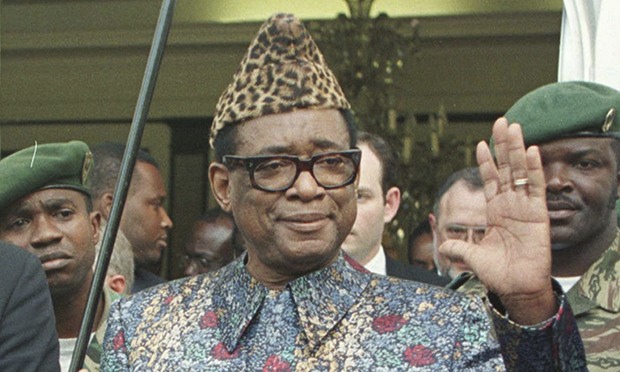 Mobutu Sese Seko pictured in Kinshasa a month before he was overthrown in 1997.
Mobutu Sese Seko pictured in Kinshasa a month before he was overthrown in 1997.
He established these relationships and they work on many different levels: There’s the relationship between individual musicians and their patrons that become inscribed in the social fabric of Zaire, now Congo; there’s the relationship between musicians and their public; there are relationships between musicians, between artists, that during the course of a 32-year dictatorship were deeply ingrained. And so part of what I have observed in my work in Congo, is that many of the mechanisms that Mobutu set in motion are reactivated by the kind of relationships that exist between the community and between many of the N.G.O. and humanitarian organizations in the region. There is a kind of repetition of many of the dynamics that were at work between musicians under Mobutu and the state under Mobutu. In that the power-holding entities in that configuration are no longer the state, they’re now part of this international body, but they hold power nonetheless, they have very specific set of objectives; they have very specific organizational criteria that describe how to go about meeting those objectives and they recognize the power of music in achieving that. And that’s very different from achieving a configuration that looks to musicians, filmmakers, all different genres of artists from a more Lumumbist perspective, as I would analyze it, as those members of society whose skills are able to articulate the ineffable and galvanize a kind of unity that grows out of autonomy and insight. Those are just two different sets of relationships.
And so, in my own analysis of the situation, I see the struggle of artists to identify themselves as very indicative of the pull they feel between these different poles, these different ways of enacting their art, their music, that there’s the physical reality, people need to eat, people need to survive. And for artists whose patrons are N.G.O.s, that physical, material need definitely comes into play. And there’s a lot of language that evolves around that, I mean, we’re talking about engagement and activist and humanitarianism, all of those terms carve out territory in this set of relationships with international N.G.O.s and international humanitarian organizations that are important for the survival of artists.
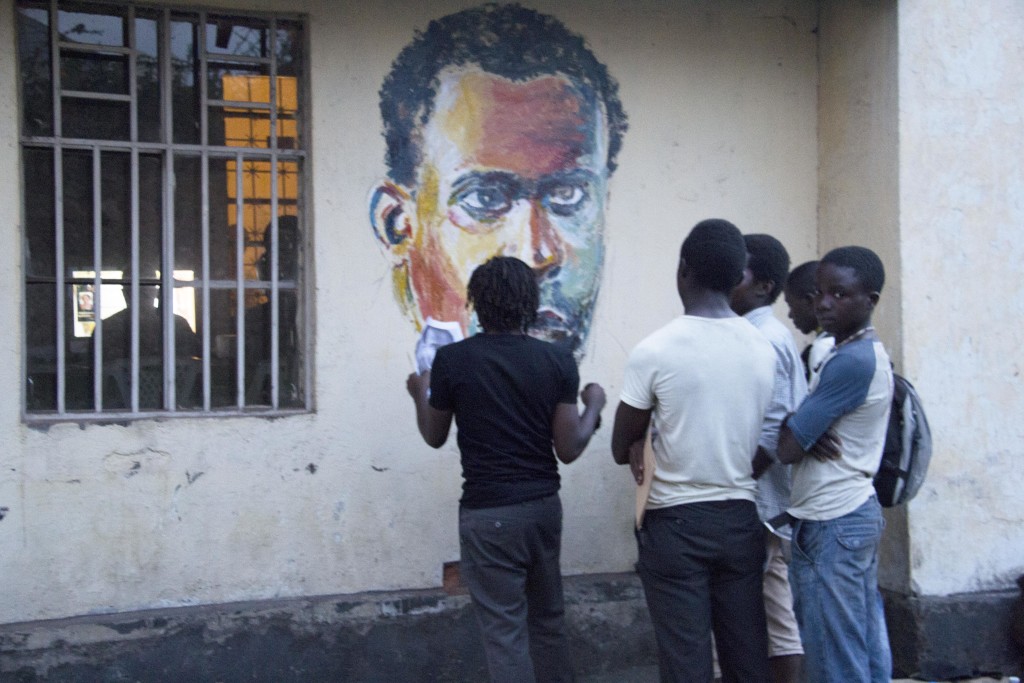 A painting of Frantz Fanon at Yolé! Africa. Photo by Allason Leitz
A painting of Frantz Fanon at Yolé! Africa. Photo by Allason Leitz
And, that’s a different impulse than the cultural impulse put forward by more of the radical thinkers. I again trace this back to Lumumba, back to Frantz Fanon and his thinking. And that’s very much the school of thinking out of which artists like Petna grow, who understands that there is a much larger potential impact of art, and that the risk of diluting that with situations where artists are mouthpieces of power that are not ultimately serving the autonomy of the local community is a very, very dangerous dynamic.
In what way? Can you describe it?
Because it dilutes the most potent tool of autonomy: As soon as art is for sale, as soon as creativity is for sale, as soon as foreign entities have the option of coming in and masquerading as collaborators with locals, the real potency of art as a form of resistance becomes diluted, because people can’t hear the difference.
I’ve noticed a lot of what I would call "N.G.O.-speak" from some of the artists we interviewed. You know, people talking about sensibilisation [raising awareness], encadrement des jeunes [mentoring], and things like that. Where does that come from?
That’s what pays! When you hear N.G.O.-speak, you’re hearing the repercussions of the system. This is what people have learned gets them work and gets them fed. So…
Right. Some artists were saying, “No, it doesn’t bother me to work with N.G.O.s, this is something that I might be singing about anyways. So if an N.G.O. wants to use my song and they’ll pay me for it, that’s O.K.”
Right, there’s a huge spectrum, and obviously people have to be able to live with themselves as well. It’s a very, very complicated set of dynamics and I don’t think any of the N.G.O.s come to the region saying, “Let’s make things more complicated,” or “Let’s undermine the art scene,” or “Wow, if we can just control the music, then we can really destroy this community.” No N.G.O. administrator or volunteer or anybody in between wants that to be the situation. The reality is that there are a set of conditions that have been cultivated by a historic series of events that continue to be activated by the dynamics that exist. And that’s my analysis looking at a much larger picture.
I think that a lot of the individual language that you get from musicians now is the result of a complex series of historical forces, and the current N.G.O.s in Goma at this moment are a trigger, but they’re a trigger of something that has a lot of layers and is a very finely crafted social fabric that has had music in particular and art in general at its core in their pivotal moments in really important ways for a really long time. I think N.G.O.s are largely oblivious to that. I think people have sort of rallied around this idea that music is a great tool of education and sensitization, music is a force that has been identified as powerful, and I agree with that, but it’s a force that is dangerously easy to take out of any historical context. And I think that’s part of what leads to the very schizophrenic language from artists who are trying to navigate their own experiences of what music means, culturally and historically, and the demands that music enables them to fulfill in the contemporary moment.
Can we talk about specific projects where N.G.O.s used music, or how N.G.O.s engage with music or artists in general?
Music is the conduit of all kinds of information with N.G.O.s: There’s a case study in my book about an N.G.O. working in Goma that was using music as a way of raising awareness for the prevention of cholera in internally displaced persons camps. Music has been used as a tool of education about voting rights and democracy and the obligation of people to vote—certainly not to influence who to vote for, N.G.O.s certainly don’t do that, obviously political musicians or politician’s musicians definitely do that. It’s everything: environmental awareness and clean water initiatives and educate girls initiatives and it’s actually harder to think of a subject that hasn’t had some sort of musical "sensitization"— and that’s the word that you’ll hear artists say all the time.
Right, which means education with a specific goal?
Yes, it’s education with a specific goal. And it’s a very interesting practice of crafting the songs; you know, an N.G.O. will commission the song and the artist will write the song and bring the lyrics and the N.G.O. will "correct" them, and the artist will then respond to the corrections, and there’s a big back and forth until the N.G.O. is satisfied and they pay a fee for the song. It’s very much like commissioning artisan labor. To me, that’s very different than empowering musical and artistic autonomy and creativity, and having the conversations that help people develop their aesthetic sensibilities or their stylistic sensibilities. Those are very, very different activities.
Right. When I spoke with Petna, he mentioned, as an example of how Yolé! Africa functions differently, a case where they’d been approached by an N.G.O. to find artists to do a song about cholera. And he said, “Well, that’s not how we work. We’ll call a meeting, and we’ll ask, is cholera affecting people’s lives, do you think cholera is something we should write music about?” And some people said “Yeah.”
And some people said, “Yes,” and it was really interesting because their diagnosis for preventing the spread of cholera was a radical one, which said, “If international N.G.O.s, if the international community wants to do something to reduce the spread of cholera, stop backing the rebel armies that are pushing people off their lands and into the IDP camps, because if they weren’t in those camps, cholera would not be spreading. So if you actually want to do something that’s a meaningful intervention, stop backing your own governments that are funding these proxy armies and that are arming these proxy armies and that are training the proxy armies, stop doing that! Get the people in your own countries to be aware of what their foreign policy is doing, that it’s your foreign policy that is creating the spread of cholera here.”
And how did the N.G.O. respond to that?
They commissioned a song about handwashing.
So they didn’t, they wouldn’t take that song?
So, again, this is one of the case studies in my book—They were much larger-minded than many N.G.O.s would have been, in that circumstance. They were in a tight spot themselves, because they have a specific organizational mandate, and it doesn’t have to do with international policy change at home, it has to do with public health abroad, right? So they were in a tight spot. What they chose to do was to renegotiate the project such that they could support a theater group that did a skit and support that group to record their song. They gave the prize for the competition to that theater group, but they did also then fund the recording of the second-place song, "Mazao," that was actually nominated by the jury in response to the community’s reflection on the cholera epidemic.
The eternal optimist in me is willing to say that the silver lining is that it triggered Yolé! Africa to start the “Art on the Frontline” series, and the first episode in that series in the song that, artistically speaking would have been the anti-cholera song. And if you read the lyrics, it’s very much about autonomy, it’s about ownership and all those things. That is an artistic response, from the community, when they are not beholden to N.G.O. negotiations over the content of the song, when they aren’t beholden to a contract, when they’re actually speaking as artists in the community. I do a lot of work with students in the United States, putting those two songs back to back, and it’s incredible how radical the effect is of trying to appeal to an organizational mandate.
That’s quite a story. Petna told me that the singer Wanny S. King had a song banned recently, but in his interview, Wanny didn’t mention that at all. So what are the real or perceived restrictions on freedom of artistic expression in the region?
So the thing that I’ve come to understand and quite respect in trying to pin down these concrete answers, is how much has to do with strategy and craft: There isn’t a list I could direct you to that says, “You’re allowed to say this, and you’re not allowed to say that.” Or, “Here’s the precedent for X, Y or Z.” What I’ve witnessed is that artists who are particularly creative in their approach get away with saying extraordinarily clear critiques, and that artists who are more didactic in their approach, at times, if their work is getting enough attention, get backlash for it. I see this in the filmmaking and I see this in the music. And there’s an incredible culture of telling stories, whether that’s through lyrics or that’s through visual images, in ways that are indirect but undeniable and very clear. So what I’ve seen is that people who, in certain instances don’t strike that balance, then certainly, there are responses. Again, it’s related to popularity.
For example, we had a situation during SKIFF [Salaam Kivu International Film Festival] some years back, during one of the open-air concerts, at an open mic. There was a group, Bana Bwisha Family, who had recently had a member of their group killed, and were responding very emotionally, very powerfully, to what they felt was the failure on the part of soldiers and military officers to secure people’s safety. They had a chorus in their song that was outright saying, “You, the soldiers, you rape the women, you, you’re corrupt, you brutalize people, you loot.” And they were saying this as military soldiers were sitting on the wall, sort of helping us enforce security. And these guys are sitting there with automatic weapons. The rappers were not metaphoric or hyperbolic in their critique, …they were about as blunt as you can be.
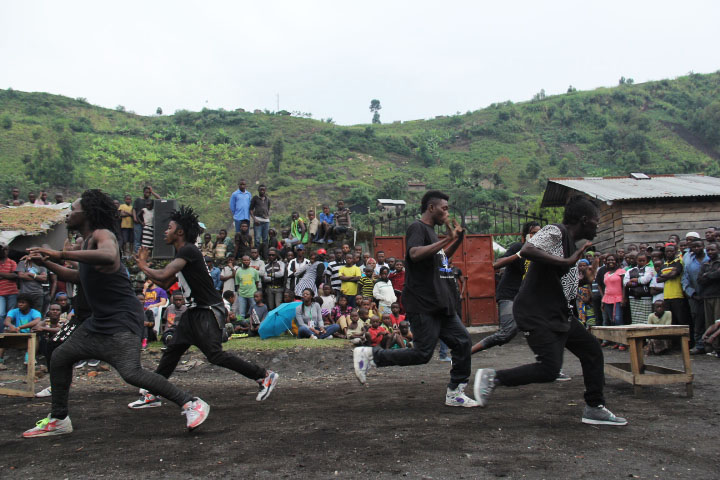 Sake Street Dance Movement Dancers at SKIFF 2015. Photo by Allason Leitz
Sake Street Dance Movement Dancers at SKIFF 2015. Photo by Allason Leitz
And it was very interesting for me to watch Petna do an impromptu emcee maneuver to try and translate their frustration, try and translate their critiques into an invitation for the soldiers to then respond by recognizing that there are grave flaws in the military structure, but that’s not necessarily an indictment of each soldier individually. And it actually turned into a really powerful conversation with some of the military officers; most of that conversation happened behind the scenes between a few of us, and a couple of the artists and a few of the military officers. But Petna made a very public wordplay where he took a verse, a lyric from this chorus that was accusatory of the police and twisted it in a way that made it clear that they are also being screwed over by the system.
And that’s the precedent he has set, and the way he works with his students is to catalyze social transformation through art, by making it a catalyst of questions and critical dialogue. So he trains his students to ask questions and to make their films in such a way that the people in question will feel implicated in helping find the answers. And if that’s your strategy, you can say all kinds of radical political critiques, because they aren’t accusatory or denouncing individuals who then find themselves backed into a corner. So there’s a lot of very radical and critical art, music and film that takes strategies along those lines, and has not been censored very much, if at all.
Things are also changing a little bit now, because of the recent events in Kinshasa where young arts organizations have organized some activities that try to insert art into politics in the most literal sense, and that didn’t go over well. And so currently there’s a real heightened alert on the part of political and military officials to view art with skepticism and to react, to be proactive in their reactions. I have yet to see the longer term effects of those strategies in the east, but it’s palpable.
O.K., but on a practical level, are artists being arrested? Are there public bans of songs?
So…It’s such a complicated thing. Yes, artists get arrested…So, for example, a year ago, when Peace One Day did their first concert in Goma, a bunch of artists protested their concert, because they had a number of concerns and you can read all kinds of criticisms and places online where artists were able to voice their concerns. And they staged a sit-in and many of them were arrested. So I could say, “Artists are being arrested in Goma for expressing their opinions and singing their songs,” or I could say, “Human beings who happened to be artists are being arrested for what’s considered to be a public disturbance.” You can read it however you want to read it. So yes, artists are being arrested, and there’s always context.
That’s very interesting. I wanted to go back to Bana Bwisha Family: Petna’s way of responding wasn’t to tell them, “What you’re doing has no place here.”
No, never. So this is what I’m talking about, the culture of cultivating artistic militancy is about constantly capitalizing on these moments where learning can happen, where transformation can happen through dialogue, and not limiting that to the agenda of an N.G.O., the agenda of a humanitarian organization, or the organizational limitations or restrictions of any given entity, but realizing that all of this stuff is happening in real time, in every single little tiny human interaction. And as we see these things, the more conscientious we are, we can recognize them and respond to them also in real time, also in every human interaction, and create a kind of fodder out of these exchanges that ultimately becomes, in my interpretation, the structural foundation for sustainable social transformation, because it’s an internal transformation, it’s a transformation that people feel agency over.
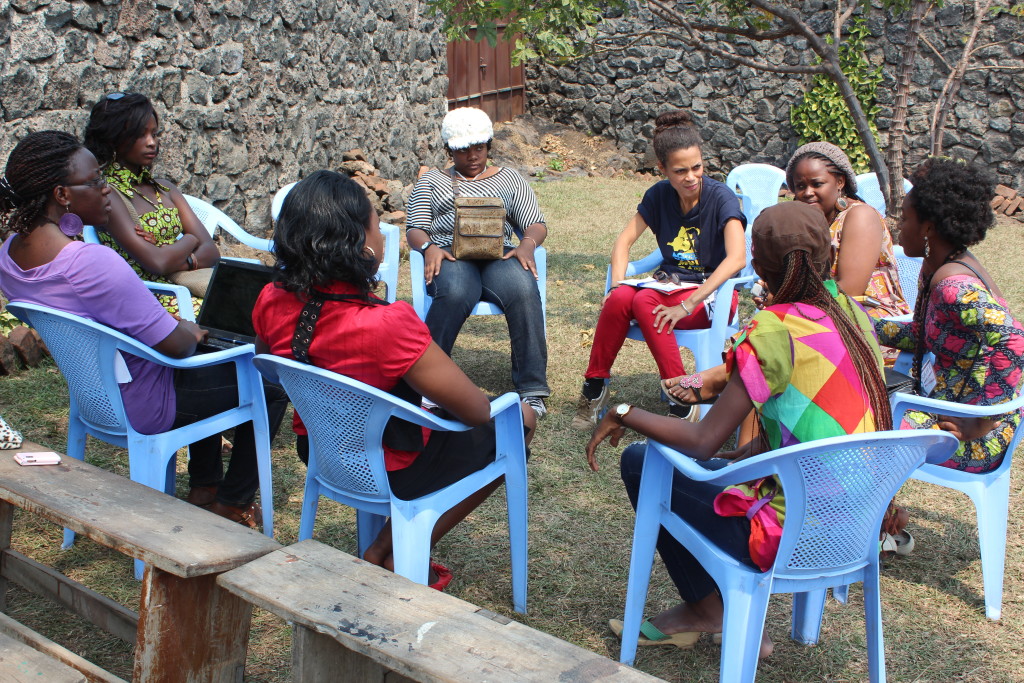 Women in Art group meeting at SKIFF 2013. Photo by Allason Leitz
Women in Art group meeting at SKIFF 2013. Photo by Allason Leitz
We asked all the artists about three festivals: Salaam Kivu International Film Festival [SKIFF], Amani Festival and Peace One Day. Do you feel that festivals like these, they all have a goal of achieving peace…
No, no, they all have a rhetoric of peace, and I don’t think there’s such a thing as "festivals like these." I think those three festivals have diametrically opposed agendas.
In what way do they have diametrically opposed agendas?
So, in my scholarly analysis of this dynamic, I think of vertical vs. horizontal vs. diagonal approaches to this topic. There’s this new trend that makes it really popular for festivals to somehow become peace-building bodies. And I see a lot of potential for that, and I also see a lot of potential for that to become an entirely superficial and meaningless activity. And, for me, in trying to parse the difference between what is meaningful and what is superficial, I’ve had to struggle with definitions of what is peace, what does it mean, what is the role of art, what is the role specifically of a festival in negotiating peace. And I have come to recognize that there are very, very broad definitions of all of those things. Some organizations view peace in terms that are best negotiated in top-down, hierarchical, or vertical structures, and some organizations view peace in terms that are best negotiated in horizontal structures, and some organizations are trying to sort of navigate both worlds simultaneously, which I refer to as diagonally.
So, mapping this onto the three examples that are the highest profile peace-based arts festivals in Goma: There’s Peace One Day, which I describe as a vertical structure; this is an organization that looks at peace in a very quantifiable way, and looks at measurable outcomes that can be obtained in a specific moment in time. And the way to attain such measurable outcomes is to get powerful people and powerful funders in place to support the agenda that they propose. So they have mega-funders, and they work with high-level U.N. agencies and they work with governments and all of those kinds of things. And from there, their programs ideally trickle down into local communities.
The opposite of that, which I call a horizontal model, is something like SKIFF, which is a festival that builds peace through all of these little, tiny interpersonal interactions: through education, through exchange, through creating channels for dialogue and giving people the skills to engage in dialogue, through fostering people’s imaginations and helping them access things that stimulate their imagination so they can imagine themselves participating positively and actively in their environment. That kind of work is based on a different understanding of peace.
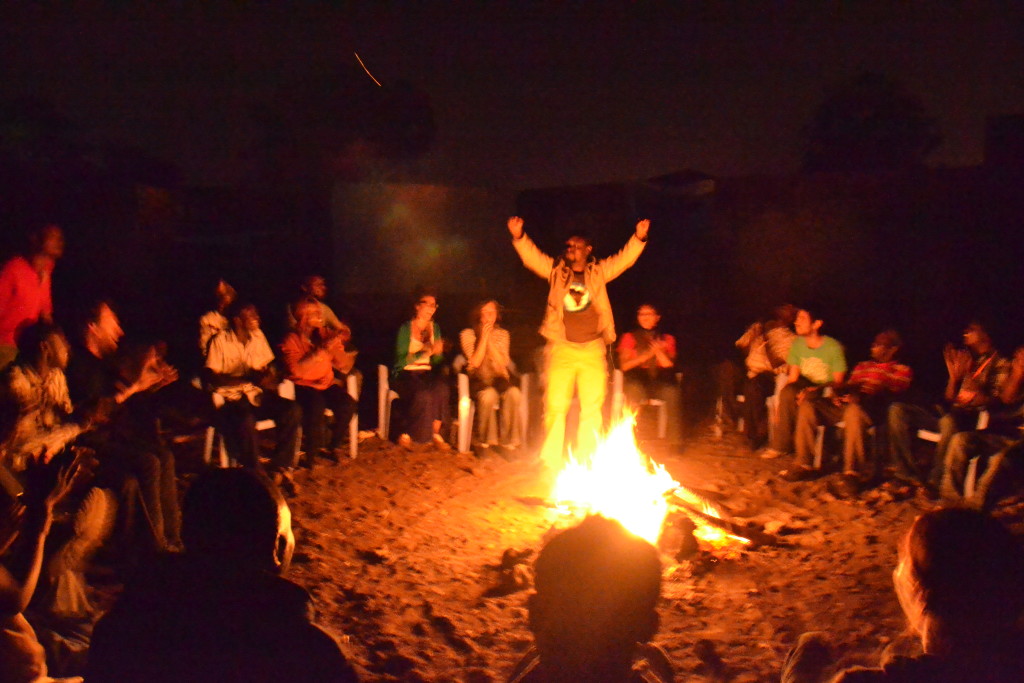 Bonfire storytelling at SKIFF 2015. Photo by Allason Leitz
Bonfire storytelling at SKIFF 2015. Photo by Allason Leitz
And then there are organizations that I refer to as diagonal that are really interested in the benefits of the horizontal model and are still aligned with the power structures that are definitive of the vertical model and are trying to navigate both of those, simultaneously.
Like the Amani Festival.
I view Amani as a festival that is a good example of that.
O.K. And so, in your analysis of festivals and festival culture as something to promote peace, what can you can say about the success of those three festivals?
Well, so the success is directly measured by the definition people have of peace, right? So for some organizations, attendance is a metric of success: “We had X number of thousands, or hundreds of thousands of people, which means we brought them together, there were no fights, which means it was a peaceful gathering, right?” So that’s a metric. Funding is sometimes considered a metric of success. From the point of view of an organization like Yolé!Africa or a festival like SKIFF, success is much harder thing to quantify, because it’s a very qualitative experience. Yolé! Africa’s definition of peace, or understanding of peace is that peace is a way of life. And measuring the things that enhance one’s ability to live a peaceful life is a very, very difficult thing to do, it has to do with self-esteem and self-perception and basic skills and capacities that may or may not even be measurable until a significant amount of time has passed and people have really developed the skills in a much more deep way.
Can you give specific examples from Yole! of that kind of horizontal interaction that you feel is peace-building, and just how that works?
It works because people sit in the space and they talk about ideas, and they learn each other’s names and they learn about each other’s families and they brainstorm and they argue and they disagree and they come up with creative, collaborative solutions and at the end of the day, they produce a song or they develop a choreography that says something that they want to say to the world, and they feel a sense of camaraderie and they develop a sense of having been seen and heard and seeing and hearing others.
You know, my own personal subjective opinion based on a lot of scholarly research and observation and evidence [Laughs], is that there is something really important that takes place in these interpersonal exchanges, that something really important happens when individuals from a community are the center of the discussion of remedying the social ills of the community, that is transformative and that leads to a kind of peace in which everybody feels personally invested. The point is that people feel like it’s theirs, it’s theirs to sustain, and to me that’s really powerful. People don’t feel ownership over things that are imported, that are designed outside of the region and are being implemented whether they like it or not. Which is why they stage sit-ins and they protest, right?
So yeah, effective? There has been prolonged violence in Congo for more than 100 years. I’m highly skeptical that a one-day festival, or a three-day festival is going to do a lot to change that. I mean, we’re talking about transgenerational experience, and, in my opinion, it takes more than bringing a foreign superstar to even make a dent in that, and bringing a foreign superstar can appear to be a perpetuation of certain values that were closely connected to colonialism in the first place. So again, my read on what is successful has a lot more to do with what happens in the community when the rest of the world isn’t shining their global spotlight for 15 minutes on Goma, but with what’s really happening by virtue of the agency and the investment of the people who live in this place all day long, every day.
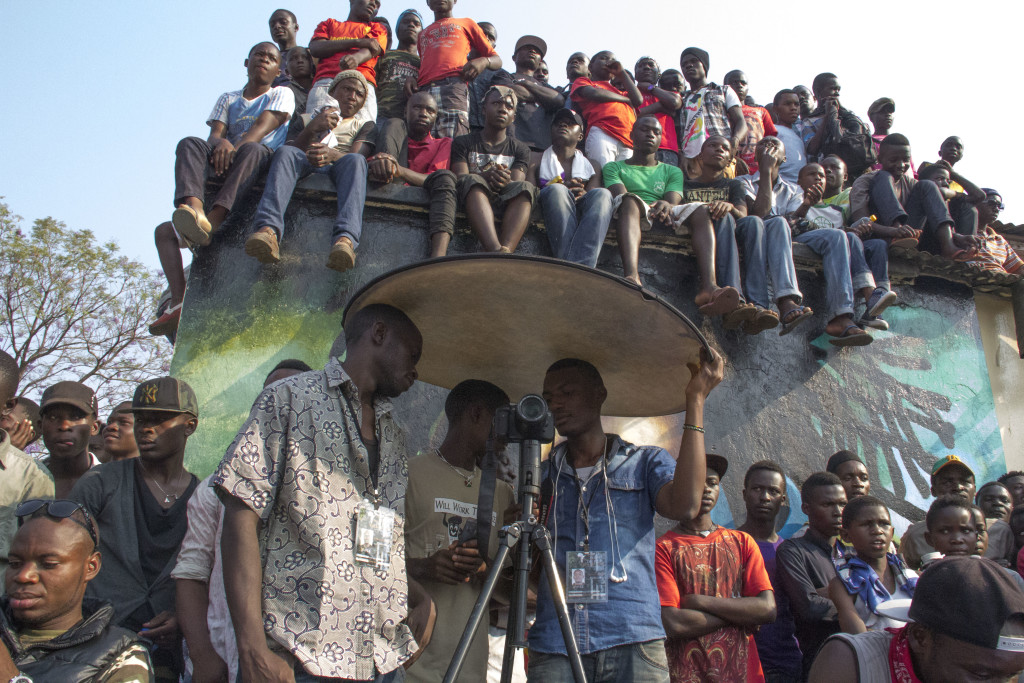 Crowd at SKIFF 2014. Photo by Allason Leitz
Crowd at SKIFF 2014. Photo by Allason Leitz
The hundreds of years of conflict in the Congo are often described as ethnically based, although I have read about the international causes and economic basis for the conflict. Some of the rhetoric of festivals as bringing peace is, “It brings people together from different places, and so we find our common humanity.”
If we further the misread of the conflict as an ethnic one, then bringing a bunch of people into the same space and having them engage in a common activity is, arguably a move towards interethnic peace. If we look at the conflict as economically driven, and geopolitically backed and prolonged, people listening to a concert for three hours and drinking a beer together doesn’t make any difference. And if we look at it from that angle, positioning people so they can represent the needs and offer solutions that are coming from the local community, is a profoundly influential thing. But it’s also threatening because it has the power to destabilize the status quo.
Right. Whenever there’s a serious conflict that’s internationally backed, there are also international N.G.O.s that come to that place and set up shop. So is it possible to see them almost as parasites on conflict?
Conflict is lucrative. Period. Music is a good way of deflecting tension from the economic issues. Music has this sort of universal appeal, and people override their critical capacities when they hear about “music that’s being made in a war zone.” That’s all fine and good when the music is organically and autonomously coming out of the local community, but co-opting music and putting it to the service of an organizational agenda is a very dangerous thing.
And, final question: What is your definition of peace?
So, I have multiple definitions of peace: the way that Yolé! Africa is most powerfully able to advocate peace is by looking at the power of art to catalyze internal transformations within an individual, which then becomes contagious within a smaller unit like a family, which then becomes contagious within a collective unit like a small community and then has a sort of exponential ripple effect to it.
So, I’m very much convinced that people who have an enhanced sense of their own individual sense of agency and have an enhanced set of critical thinking skills and have the skills and the confidence in their ability to engage with the world nonviolently, that creating those conditions for individuals is a radical peace-making activity. Because that addresses many different levels of the definition of peace: That addresses peace with oneself, that addresses the ability to maintain interpersonal peace, that addresses the ability for people who have a stake in the community to make the kinds of structural changes that lead to the larger scale negotiations of sustainable political peace. To me, that’s where art is powerful. To me it is less powerful to articulate this rhetoric of peace, peace, peace, peace, if it doesn’t manifest in sustained actions on a level that is transformative.
Thank you so much Chérie. We look forward to reading your book soon!









